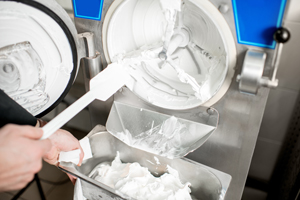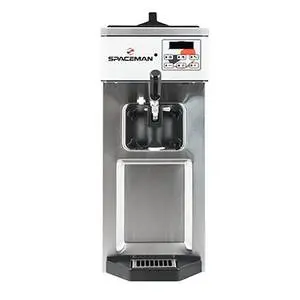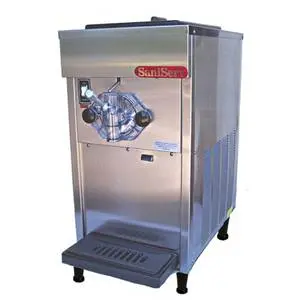A soft-serve ice cream machine is a great way to add revenue to your existing restaurant or convenience store
A restaurant's energy bill is one of its largest expenditures, but is one of the most manageable as well. To effectively increase your energy efficiency involves more than just using less energy - it requires you becoming aware of how energy is used, where it is wasted, and how it can be used more effectively and efficiently. There are a few simple steps business owners can take to cut their utility bill and increase profit potential. Consider these five ideas from the foodservice industry experts at ACityDiscount.
Does the warming weather leave you longing for a cool, creamy treat? If so, you’re not alone. Right now, is the perfect time to invest in a soft serve ice cream machine for your restaurant or convenience store business.
Offering soft serve is a great way to make a fast profit in your foodservice establishment. Soft serve ice cream is lower in milk fat than hard ice cream making it a healthier alternative to traditional hard ice cream. It is typically paired with treats such as candy, cookies and served in a bowl or in a cone making it a popular item on most menus.
Since its introduction in America in the 1930s, the popularity of soft serve ice cream has grown. If you want to offer soft serve ice cream at your establishment, you will need to purchase a soft serve machine. The machine works by adding air to a special soft serve ice cream mix to increase its volume. Machines run at a temperature around 18 degrees Fahrenheit, which, when combined with the air, makes for the soft, easily dispensable product we all know and love.
Not all ice cream making machines are created equal. The best soft ice cream making machine should minimize chances of contamination and get the job done efficiently. The right machine shaves off variable costs marginally. The experts at ACityDiscount offer five main features to consider when shopping for and maintaining a soft serve ice cream machine.
Size: Machines are compact compared to other types of restaurant equipment and come in either countertop or floor models. Smaller service operations that want to offer soft serve ice cream often own modest countertop machines, which allow an employee to refill and make new batches as needed. Buffet and sundae bars are usually self-service, and these operations typically purchase large, freestanding machines to maintain higher volumes of ice cream. Larger machines, however, cost more to purchase, operate, and maintain as well. Before buying a machine, know the number of batches you will need at any time, amount of peak time you have, and the level of noise you can tolerate.
Capacity: As with many other types of equipment, one significant point to consider when selecting a soft serve machine is capacity. Machine capacity is measured in volume, either gallons per hour or servings per minute. Lower volume is generally 2-3 servings per minute, medium is 4-5 servings and high volume is 7 servings. When shopping, pay attention to the volume ratings: low-volume machines offer two to three servings per minute, mediums make four to five, and highs can make seven servings per minute.

Energy source: Consider where you plan to place the machine and what energy source is required. Many small soft serve machines run on a single-phase 115 volts and larger units run on about 230 volts. Electric machines with compressors are easy to use. They can whip out several ice cream batches without longer lead times and/or intermittent breaks. Soft serve ice cream machines work efficiently to freeze and add air (volume) to special liquid soft serve ice cream mixtures. Machines run at a temperature around 18 degrees Fahrenheit, keeping the ice cream not only frozen, but at proper storage temperatures. Because of this, these machines must run both day and night to prevent any changes in consistency or health code violations. Check with your local health department about regulations for soft serve ice cream. Then, ask about maintenance requirements for each machine you are considering ensuring you are able to complete them all in a timely fashion.
To ensure minimal utility bills, look for energy-efficient models with the ENERGY STAR® seal.
Design: Every manufacturer has different designs, but the two main features to research are the freezing cylinder and the dasher bar that mixes the product. The machine should have an accessible freezer bowl and control panel/knobs (possibly programmable) for easy control of the process. Most large soft serve machines come standard with a hopper agitator. The hopper agitator keeps product in the storage area (hopper) mixed and cooled, saving your employees precious time throughout the day.

Maintenance: To properly maintain your soft serve machine, it will need to be cleaned properly and on a consistent basis. Start the cleaning process by completely emptying your machine. Clean out any leftover ice cream in the machine and blades. Next flush the machine by running water through the unit. Water should be able to get through the machine without any blockage. If there is a blockage, you will have to go back and clean out any missed spots. If the machine is empty, water will run through clear. The next step is to disassemble the machine. Detach any moving parts that may come in contact with ingredients during the ice cream making process. Soak the removable parts in warm soapy water then rinse with water and dry. Once the parts have dried completely, put the machine back together.
Have questions on purchasing a soft serve machine? Call the food service experts at ACityDiscount at 404-752-6715 for more information.





